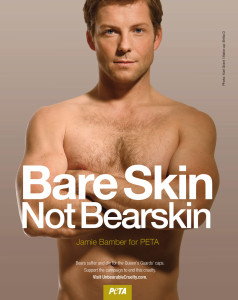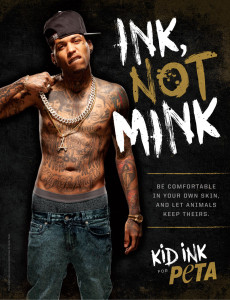In a nutshell: We do not live in a post-gender society where women’s and men’s bodies are interchangeable. Men’s bodies are portrayed and perceived in much different ways that women’s bodies. Women’s bodies are also the vast majority of those bodies that are sexually objectified in the media (over 95%!). The sexual objectification of women is linked to increased rates of domestic violence and sexual violence against women.
Oftentimes in the Nonhuman Animal rights movement, organizations and their volunteers will vehemently state that their sexual objectification of women is not sexist because they also use men in their campaigning. This doesn’t cut it for two reasons: 1. Women’s bodies are disproportionately sexually objectified in the Nonhuman Animal rights movement just as they are in mainstream media; 2. Men tend to be portrayed in ways that protects their masculinity and social power, whereas women tend to be portrayed in ways that reinforce their submissiveness and sexual availability.
Let’s take a look at some images taken from PETA as examples. As you peruse them, keep in mind the sexual objectification checklist:
1. Does the image show only part(s) of a sexualized person’s body?
2. Does the image present a sexualized person as a stand-in for an object?
3. Does the image show sexualized persons as interchangeable?
4. Does the image affirm the idea of violating the bodily integrity of a sexualized person who can’t consent?
5. Does the image suggest that sexual availability is the defining characteristic of the person?
6. Does the image show a sexualized person as a commodity that can be bought and sold?
The common factors in these images are direct eye contact with the camera, a threatening or powerful pose, and display of strength and prowess. Indeed, many of these pictures demonstrate hyper-masculinity. Look at the hand positions of these men: They are demonstrating command over space, command over their body, and command over the viewer. Men are not being used as objects, and their personhood is protected. There is no sexual violation, and there is no compromised consent. They are not shown as interchangeable, and they are not shown as sexually available. These images don’t say, “Come and get me,” they say, “I’m coming to get you.”
Some images depict naked men, but these are often shown as humorous. Because sexually objectifying men is so rare and so abnormal for our understanding of masculinity, it becomes funny.
In images where men and women are pictured, the difference is easily spotted. Notice how this man is facing the camera head on, displaying no vulnerability. The woman, however, faces the camera from the side, leans on him, and is standing on one foot on tip toe, demonstrating her vulnerability. Indeed, many mixed-gender images show women leaning on men for support.

See also this image where Corey Feldman is facing the camera head on, playing an instrument, and in command of his space. His wife is shown leaning on him, and looking at the camera from an upturned face. Much more of her body exposed. She is not in command of her space, but rather she is finding support on the man.
 Dr. Wrenn is Lecturer of Sociology. She received her Ph.D. in Sociology with Colorado State University in 2016. She received her M.S. in Sociology in 2008 and her B.A. in Political Science in 2005, both from Virginia Tech. She was awarded Exemplary Diversity Scholar, 2016 by the University of Michigan’s National Center for Institutional Diversity. She served as council member with the American Sociological Association’s Animals & Society section (2013-2016) and was elected Chair in 2018. She serves as Book Review Editor to Society & Animals and has contributed to the Human-Animal Studies Images and Cinema blogs for the Animals and Society Institute. She has been published in several peer-reviewed academic journals including the Journal of Gender Studies, Feminist Media Studies, Disability & Society, Food, Culture & Society, and Society & Animals. In July 2013, she founded the Vegan Feminist Network, an academic-activist project engaging intersectional social justice praxis. She is the author of A Rational Approach to Animal Rights: Extensions in Abolitionist Theory (Palgrave MacMillan 2016).
Dr. Wrenn is Lecturer of Sociology. She received her Ph.D. in Sociology with Colorado State University in 2016. She received her M.S. in Sociology in 2008 and her B.A. in Political Science in 2005, both from Virginia Tech. She was awarded Exemplary Diversity Scholar, 2016 by the University of Michigan’s National Center for Institutional Diversity. She served as council member with the American Sociological Association’s Animals & Society section (2013-2016) and was elected Chair in 2018. She serves as Book Review Editor to Society & Animals and has contributed to the Human-Animal Studies Images and Cinema blogs for the Animals and Society Institute. She has been published in several peer-reviewed academic journals including the Journal of Gender Studies, Feminist Media Studies, Disability & Society, Food, Culture & Society, and Society & Animals. In July 2013, she founded the Vegan Feminist Network, an academic-activist project engaging intersectional social justice praxis. She is the author of A Rational Approach to Animal Rights: Extensions in Abolitionist Theory (Palgrave MacMillan 2016).
Receive research updates straight to your inbox by subscribing to my newsletter.












